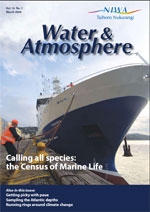PDF of this article (121 KB)



Visiting scientists: Studying sea anemones and black corals at NIWA
Following on from the Census of Marine Life meeting in Auckland, Dr Daphne Fautin from the University of Kansas and Dr Tina Molodtsova from the Shirshov Institute of Oceanography, Moscow, spent time in Wellington working with the NIWA Invertebrate Collection.
Dr Fautin is the leading authority on sea anemones anddeveloped the Hexacorallians of the World database, a website about taxonomy, nomenclature, and geographic distribution of living hexacorallians: sea anemones, tube anemones, black corals, and stony corals.
She’s working on a revised list of the New Zealand seaanemones based on her examination of the NIWA collection, with a particular focus on material recently acquired through seamount and MFish observer programs. She also gave a training workshop on anemone biology and classification for NIWA staff.
Dr Molodtsova is an authority on tube anemones as well as black corals and contributes to these two groups in the Hexacorallians of the World database. While in New Zealand, she identified a selection of these animals collected at sea during Oceans 2020, various seamount and trawl surveys, and from observer trips. She also provided taxonomic advice to NIWA staff and helped prepare educational material about protected black corals as part of a Department of Conservation project.
These visits were supported by funding from CenSeam, MFish, DOC, FRST, and the NIWA Capability Fund.
For further information, contact: Di Tracey, 0-4-386 0866, [email protected] Kareen Schnabel, 0-4-386 0862, [email protected]
Learn more at the Hexacorallians of the World website:geoportal.kgs.ku.edu/hexacoral/anemone2/index.cfm
Advances in integrated co-culture

Recent visitors from China and Canada gave a welcome boost to NIWA’s research into integrated co-culture, a system for growing different species together with the waste of one species providing food for another. Professor Zhaoxing Qiu, director of the Shandong Mariculture Institute, came to NIWA’s Mahanga Bay aquaculture facility for two months, and Professor Thierry Chopin from the University of New Brunswick visited NIWA for two weeks.
In NIWA’s co-culture system, the pivot culture species are salmon and mussels, and sea cucumbers serve as vacuum cleaners on the seabed, ingesting faeces and extraneous feed. In China, Professor Qiu and his colleagues have perfected techniques for separating out viable sea cucumber eggs for fertilisation and manipulating diets to induce larvae to settle. During his time at Mahanga Bay, he developed methods for spawning and settling our indigenous sea cucumber, Stichopus mollis. This is the first time that sea cucumbers have been settled and on-grown in a hatchery in New Zealand. This work complements our field research that indicates sea cucumbers are attracted to mussel farm waste, and has proved the possibility of growing our sea cucumbers in a hatchery to a size suitable for integrated co-culture under finfish and mussel farms.
Another component of our co-culture model is seaweed, which serves to soak up dissolved nutrients from farming activity, and it is in this area of our research where the expertise of Professor Chopin proved invaluable. He’s a world-renowned phycologist (seaweed specialist). In Canada he has worked closely with the salmon industry to integrate seaweed and mussel culture. The results are reduced environmental impacts and increased production and value per farmed hectare. While in New Zealand, he spoke about his work to aquaculture industry and research groups in Nelson, Wellington, and Bream Bay.
Canadian research has shown that kelp grows 46% faster and mussels twice as fast when co-cultured with salmon. Putting this in an economic context, integrated co-culture affords almost 10% higher profitability over salmon monoculture, based on a 10-year projection. These data have stimulated keen interest and given even greater impetus to realising our national goal of $1.5 billion in export earnings for the aquaculture sector by 2025.
Professor Qiu’s visit, supported by the FRST International Investment Opportunity Fund, was part of NIWA’s collaboration with the Yellow Sea Fisheries Research Institute in Qingdao. Professor Chopin’s visit was supported by the Royal Society’s ISAT linkages fund.
For further information, contact: Dr Jeanie Stenton-Dozey, 0-3-343 8030, [email protected]
Further reading Stenton-Dozey, J. (2007). Finding hidden treasure in aquaculture waste. Water & Atmosphere 15(4): 10–11.
